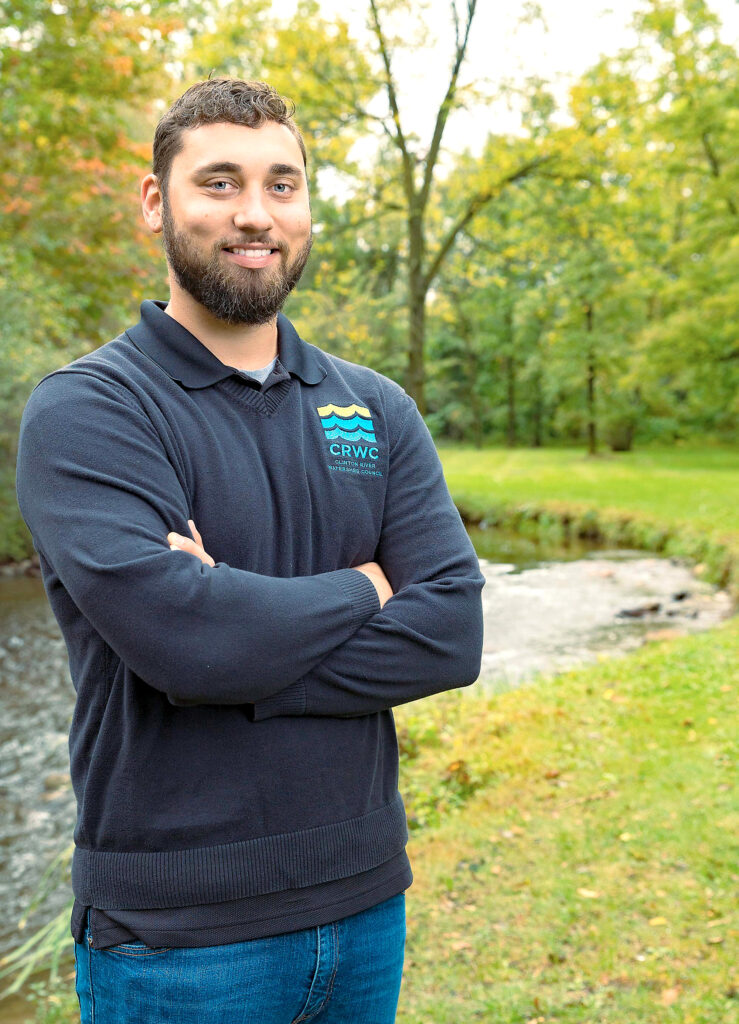
By Dean Vaglia
Leader Staff Writer
The Clinton River Watershed Council needs your help. The CRWC is holding its biannual adopt-a-stream monitoring day on Saturday, Oct. 2 and is looking for volunteers to help.
“We have seven full-time staff (members),” said Eric Diesing, CRWC watershed ecologist who gave a presentation about the adopt-a-stream program at the Oxford Public Library on Wednesday, Sept. 8. “I am the only ecologist on staff, and there is no way that I can get out to 760 square miles twice a year to collect the data that we need.”
The lack of available staff, along with the need to collect water samples and perform observations of waterway surroundings at over 50 sites around the watershed, led to the creation of the adopt-a-stream program.
Adopt-a-stream volunteers meet at one of 55 sites around the watershed twice a year on the first weekend of May and October. Volunteers take on a number of roles from coordinating the site team to snapping photographs of the site to suiting up in waders and collecting samples.
While sites are assigned by the CRWC, volunteers are able to indicate where they would prefer to monitor. Some of the sites closest to Oxford are along the Paint Creek in Lake Orion at Children’s Park and the intersection of Clarkston Rd. and Kern Rd., and along the Clinton River at Clarkston Methodist Church. Creeks and streams in Oxford tend to drain into the Paint Creek and Clinton River.
The typical adopt-a-stream outing begins with a visual observation of the area. Some of the data points collected include what the current weather is, how cold the stream is, what the current flow is like and taking the stream’s dimensions (how wide and how deep).
“And then we get into the habitat types,” Diesing said. “This is where we start delving into the ecological aspect of things.”
The ecological study begins with looking for the various habitats that can be present in a stream. This can include the conditions of a stream (is it a riffle, a pool or a run), conditions alongside a stream (are boulders or undercut banks present) and what kind of plant life are in the area (is there algae or any standing or floating plants).
From there volunteers record the condition of the left and right banks — “You always determine your right and left bank looking downstream,” Diesing said — and how bad the erosion at the site is. The surrounding land use on each side of the bank is made note of, along with which type of substrate is found at the bottom of the stream. Trash is checked for, and volunteers mark down whether the littering is so extensive as to warrant a CRWC cleanup.
After checking for invasive plant and animal species and making a birds-eye-view sketch of the stream, volunteers begin one of the most important parts of the observation: the bug search.
“They’re really good indicators of water quality,” Diesing said. “They are used throughout the world for water quality analysis and rapid bio-assessment.”
Bugs tend to stay in areas that are suitable for their survival and react to varying levels of environmental disruption in predictable ways, so their presence is a good indicator of a stream’s health.
There are three groups of bugs based on their tolerance to environmental disruption. Group One, which includes mayfly nymphs and dobsonflies, is the most sensitive to changes in their environment. Group Two, which includes crayfish and dragonfly nymphs, is somewhat sensitive to pollution and changes. Group Three, which includes leeches and aquatic worms, is the least sensitive to pollution.
“When you’re out and you’re sampling, your goal is to find the most diversity between all three groups,” Diesing said. “Basically meaning that if you find only group ones, that doesn’t necessarily mean that your system is super healthy because now you’re missing group twos and group threes. The more diverse the more stability in the system.”
With the next adopt-a-stream check on Oct. 2, interested parties are encouraged to reach out to Diesing by email at eric@crwc.org. He will reach back to you asking about where you would like to monitor, assign you to a team and get you in touch with your site coordinator. All equipment needed is provided and observations take 30 to 45 minutes.

Leave a Reply